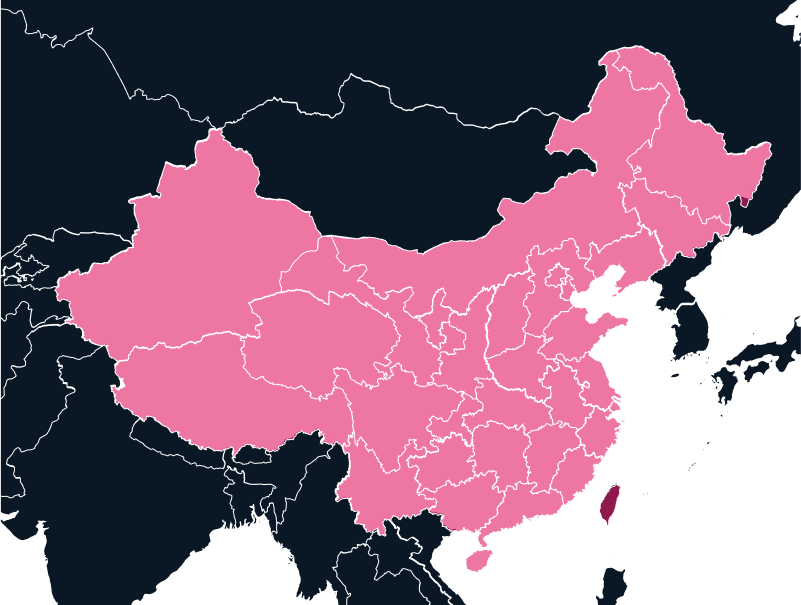Europe
Importing to China
China plays a crucial role in the semiconductor industry, accounting for about 15% of total global production. However, ongoing geopolitical tensions and supply chain issues have led to fluctuating compliance requirements and restrictions for various types of encrypted equipment and AI-related technology.

Tax
up to 13%
Duties
up to 30%
Lead Times
3-4 weeks
Restricted Items
Certain goods of USA origin
Best Carrier Option
Courier or Freight Forwarder
Non-Working Days
Saturday, Sunday, and Public Holidays
Prominent Languages
Mandarin, Cantonese
IOR Services in China
China is the global hub for manufacturing solidifying its dominance in both imports and exports. Its well-developed infrastructure, including extensive ports and logistics systems, facilitates seamless global trade, making this country a key player in international supply chains. However, due to factors such as an ongoing trade war with the US, dual-use trade regulations are constantly evolving, making compliance a challenge for prospective businesses.
China and AI Trade
In 2019, China’s total import and export of high-tech products exceeded 1.5 trillion US dollars, and international collaboration has become crucial to China’s technology development.
China is the world’s top consumer of semiconductors, using over half of all semiconductor chips globally. The future of AI hinges on this cutting-edge hardware, and East Asia, particularly Taiwan and China, alongside South Korea, is at the forefront.
Taiwan leads in advanced chip production, while China also possesses significant manufacturing capacity. Additionally, China is heavily invested in becoming self-sufficient in chip production, pouring billions into domestic companies and research – this is particularly evident as the US-China trade war ramps up.
The race for market dominance hinges on supply chain accessibility. With varying degrees of restrictions and differing compliance regulations, exporting and importing AI gear has become an arduous task. With complete transparency and a holistic approach, TecEx manages the end-to-end deployment of all AI-related tech and equipment across borders.
Population
1,411 B
Biggest Industry by Export
Electronics
Capital City
Beijing
Biggest Industry by Import
Crude Oil
Exporting from China
Exporting goods from China involves navigating regulatory compliance, including export licenses, customs documentation, and adherence to international standards. Businesses must account for tariffs, taxes, and duties while managing logistics challenges like port congestion, potential logistics issues, and choosing cost-effective shipping methods.
For items falling under dual-use categories, exporters must obtain specific licenses from relevant government agencies, such as the Ministry of Commerce (MOC). Non-compliance with these regulations can result in severe penalties, including product seizure, financial repercussions, and even blacklisting.
China Compulsory Certificate (CCC)
Compliance requirements can often pose significant challenges for importers. One critical certificate necessary for importing certain categorized devices into China is the China Compulsory Certificate (CCC).
The CCC mark is a mandatory conformity mark that indicates a product meets the safety, quality, and environmental standards set by Chinese authorities. This mark is required for over 100 products, from electrical fuses to tech equipment. It further categorizes items into primary and secondary devices. The certification process involves rigorous testing, audits, and periodic inspections to ensure the products continue to meet Chinese standards. For importers, you must apply for the CCC certification through Chinese authorities and provide all the necessary documentation, including technical specifications and test reports. If these goods do not possess the CCC mark, importers can encounter delays, fines, or refusal of entry for non-compliant goods.

Pain Points for Importing to China
A persistent trade war with the United States and its allies has hampered the import and export of tech in China. The US has imposed several trade embargoes and sanctions on China over the years for various reasons, which have impacted the Chinese tech economy. And while imports and exports in China remain strictly regulated, requiring extensive compliance, the trade war with the USA has had far less of a toll on China’s economy.
Although goods of American origin are still allowed into China, they can incur additional duty charges of approximately 10-25% depending on the HS code, making cost prediction extremely difficult for importers and exporters. Furthermore, China implements VAT with rates between 6% and 13%, depending on the product type.
Countries That Trade with China
North America
United States of America (USA)
Asia
Japan
Specialized Solution for Importing to China
Engaging in dual-use trade with China is a high-stakes process that necessitates meticulous compliance with a stringent regulatory framework and geopolitical nuances. TecEx has extensive experience in shipping to China and will be able to accurately predict changes in costs that come with specific HS codes. We ensure we are on top of all changing requirements in terms of compliance, health, and safety.
Therefore, we can ensure all goods’ packaging meets the required standard, all costing is 100% accurate, and goods clear quickly the first time. Finally, using our established relationships with world-class logistics services, TecEx will bring you the best value-for-money freight regardless of the port used.
Global Trade and China
Currently, China has 23 free trade agreements (FTAs) in force with 26 countries and regional blocs. China is a member of the Regional Comprehensive Economic Partnership (RCEP), the largest FTA in the world, and covers 15 countries in Asia. These FTAs have helped to boost trade in China and have also helped to create jobs and improve the competitiveness of the Chinese economy. Additionally, China has two Special Administrative Regions (SARs) Hong Kong and Macau. Although these regions are part of China they have a high degree of autonomy with their own laws, currencies, and immigration policies.
Important Trade Dates for Importing to China
Chinese New Year is the largest holiday in China, often leading to temporary shutdowns and slower production in various industries. This year, Chinese New Year will be celebrated from January 28 to February 4, 2025.
Your global trade solution for China
Fill in the form to get in touch, and our expert team will contact you with a bespoke customs compliance solution to suit your needs.
.jpg)


